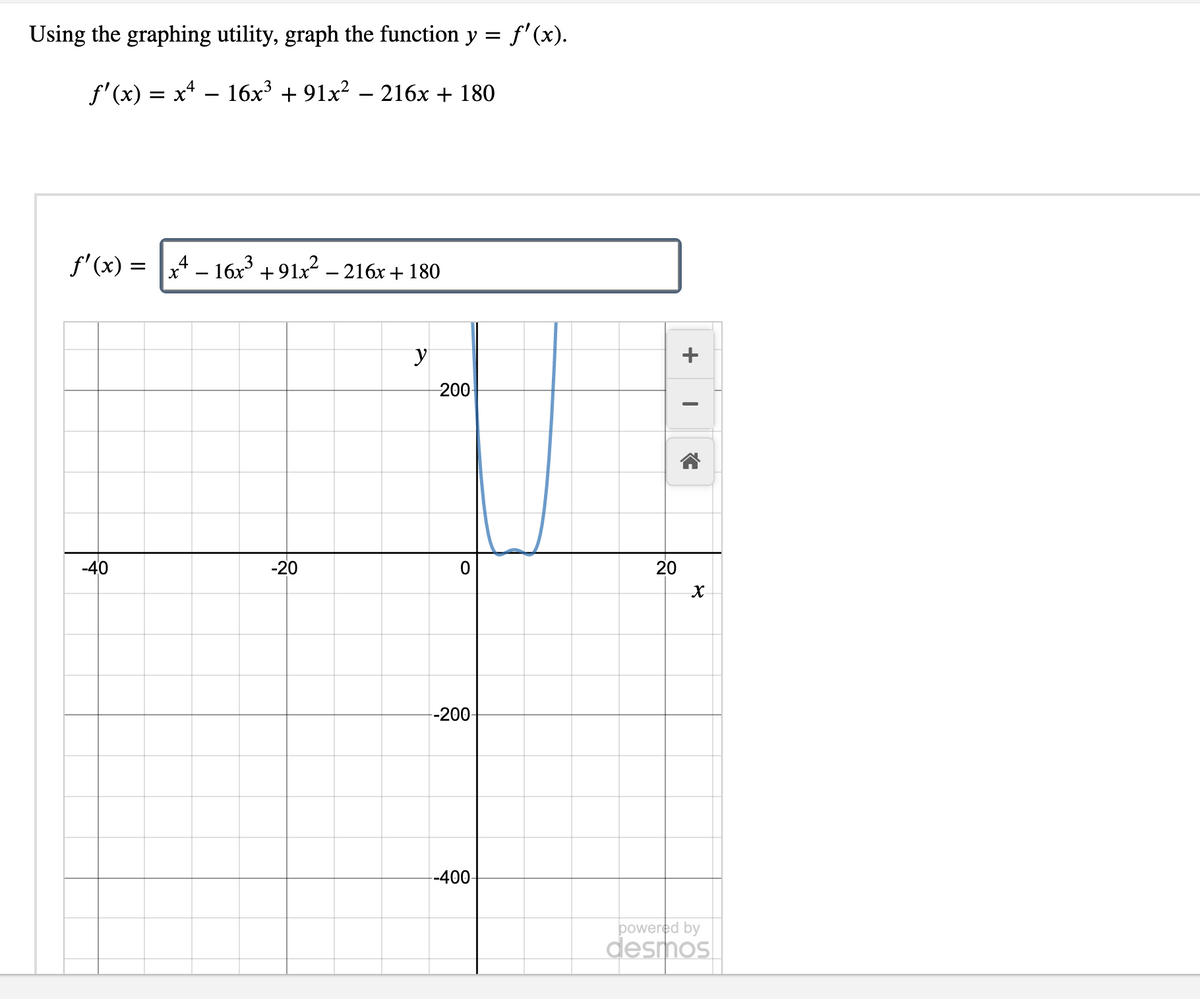Use the graph to find the point(s) of inflection of f. (Give your answer as a comma-separated list of points in the form (*, *). Use decimal notation. Give your numbers to three decimal places. Enter DNE if the function has no inflection points.) inflection point(s): | Use the graph to determine the interval(s) on which the function ƒ is concave down. (Give your answer as an interval in the form (*, *). Use the symbol oo for infinity, U for combining intervals, and an appropriate type of parenthesis "(",")", "[","]" depending on whether the interval is open or closed. Enter Ø if the interval is empty. Use decimal notation. Give your numbers to three decimal places.)
Use the graph to find the point(s) of inflection of f. (Give your answer as a comma-separated list of points in the form (*, *). Use decimal notation. Give your numbers to three decimal places. Enter DNE if the function has no inflection points.) inflection point(s): | Use the graph to determine the interval(s) on which the function ƒ is concave down. (Give your answer as an interval in the form (*, *). Use the symbol oo for infinity, U for combining intervals, and an appropriate type of parenthesis "(",")", "[","]" depending on whether the interval is open or closed. Enter Ø if the interval is empty. Use decimal notation. Give your numbers to three decimal places.)
Calculus: Early Transcendentals
8th Edition
ISBN:9781285741550
Author:James Stewart
Publisher:James Stewart
Chapter1: Functions And Models
Section: Chapter Questions
Problem 1RCC: (a) What is a function? What are its domain and range? (b) What is the graph of a function? (c) How...
Related questions
Question

Transcribed Image Text:Using the graphing utility, graph the function y = f'(x).
f'(x) = x*
16x3 + 91x? – 216x + 180
f'(x) = |x* – 16x³ +91x² – 216x +180
%3D
y
200
-40
-20
20
--200
-400-
powered by
desmos
+
![--400
powered by
desmos
Use the graph to find the point(s) of inflection of f.
(Give your answer as a comma-separated list of points in the form (*, *). Use decimal notation. Give your numbers to three
decimal places. Enter DNE if the function has no inflection points.)
inflection point(s):
Use the graph to determine the interval(s) on which the function f is concave down.
(Give your answer as an interval in the form (*, *). Use the symbol o for infinity, U for combining intervals, and an
appropriate type of parenthesis "(",")", "[","]" depending on whether the interval is open or closed. Enter Ø if the interval is
empty. Use decimal notation. Give your numbers to three decimal places.)
interval(s):](/v2/_next/image?url=https%3A%2F%2Fcontent.bartleby.com%2Fqna-images%2Fquestion%2F3bd5995a-c4b2-468d-a13c-4876a73e2cf6%2F17da13cd-6f70-490d-9de6-e7ab55e7b0f3%2Fqbxtl8_processed.png&w=3840&q=75)
Transcribed Image Text:--400
powered by
desmos
Use the graph to find the point(s) of inflection of f.
(Give your answer as a comma-separated list of points in the form (*, *). Use decimal notation. Give your numbers to three
decimal places. Enter DNE if the function has no inflection points.)
inflection point(s):
Use the graph to determine the interval(s) on which the function f is concave down.
(Give your answer as an interval in the form (*, *). Use the symbol o for infinity, U for combining intervals, and an
appropriate type of parenthesis "(",")", "[","]" depending on whether the interval is open or closed. Enter Ø if the interval is
empty. Use decimal notation. Give your numbers to three decimal places.)
interval(s):
Expert Solution
This question has been solved!
Explore an expertly crafted, step-by-step solution for a thorough understanding of key concepts.
This is a popular solution!
Trending now
This is a popular solution!
Step by step
Solved in 4 steps with 1 images

Knowledge Booster
Learn more about
Need a deep-dive on the concept behind this application? Look no further. Learn more about this topic, calculus and related others by exploring similar questions and additional content below.Recommended textbooks for you

Calculus: Early Transcendentals
Calculus
ISBN:
9781285741550
Author:
James Stewart
Publisher:
Cengage Learning

Thomas' Calculus (14th Edition)
Calculus
ISBN:
9780134438986
Author:
Joel R. Hass, Christopher E. Heil, Maurice D. Weir
Publisher:
PEARSON

Calculus: Early Transcendentals (3rd Edition)
Calculus
ISBN:
9780134763644
Author:
William L. Briggs, Lyle Cochran, Bernard Gillett, Eric Schulz
Publisher:
PEARSON

Calculus: Early Transcendentals
Calculus
ISBN:
9781285741550
Author:
James Stewart
Publisher:
Cengage Learning

Thomas' Calculus (14th Edition)
Calculus
ISBN:
9780134438986
Author:
Joel R. Hass, Christopher E. Heil, Maurice D. Weir
Publisher:
PEARSON

Calculus: Early Transcendentals (3rd Edition)
Calculus
ISBN:
9780134763644
Author:
William L. Briggs, Lyle Cochran, Bernard Gillett, Eric Schulz
Publisher:
PEARSON

Calculus: Early Transcendentals
Calculus
ISBN:
9781319050740
Author:
Jon Rogawski, Colin Adams, Robert Franzosa
Publisher:
W. H. Freeman


Calculus: Early Transcendental Functions
Calculus
ISBN:
9781337552516
Author:
Ron Larson, Bruce H. Edwards
Publisher:
Cengage Learning